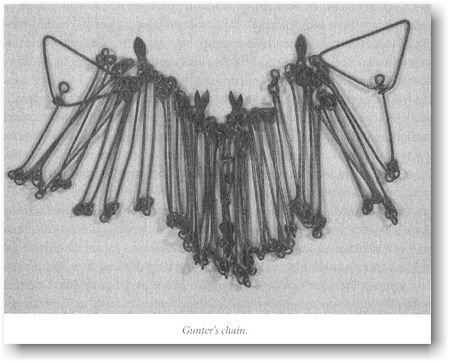
From
Andro Linklater's “Measuring
America - How the United States was Shaped by the
Greatest Land Sale in History."
In
this book Gunter first described the chain that was to bear his name. "For
plotting of ground, I hold it fit to use a chaine of foure perches in length, divided into an hundred links.”
The practical appeal of a chain was that, unlike a rod, it was flexible enough
to be looped over a person's shoulder, and that, being made of metal, it neither stretched nor shrank as cords always did.
Other kinds of chain had been devised, but the supremacy of Gunter's came from
his fascination with ratios and the relationship of one set of numbers to
another. As a passionate believer in the usefulness of math, he built into his
chain the most advanced numerical learning of the time until it could almost be
compared to a primitive calculating machine.
Four
perches measured 22 yards, a strange distance that makes sense only in the
context of the traditional units used for measuring land. Like all units of land
measurement, a perch, also known as a rod or a pole, originally varied
according to the quality of ground-a perch of poor soil was longer than one of
fertile soil-but in the course of the sixteenth century it became standardized
at 161, feet. This inconvenient length was derived from the area of
agricultural land that could be worked by one person in a day-hence the
variability. The area was reckoned to be 2 perches by 2 perches (33 feet by 33
feet). Thus a daywork amounted to 4 square perches.
Conveniently, there were 40 dayworks in an acre, the
area that could be worked by a team of oxen in a day, and 640 acres in a square
mile. It was significant that all of them were multiples of 4, a number that
made it simpler to calculate the area of a four-sided field.
Gunter
divided the chain into 100 links, marked off into groups of 10 by brass rings.
On the face of it, the dimensions make no sense: Each link is a fraction under
8 inches long; 10 links make slightly less than 6 feet, 8 inches; and the full
length is 66 feet. In fact, he had made a brilliant synthesis of two otherwise
incompatible systems, the traditional English land measurements, based on the
number 4, and the newly introduced system of decimals based on the number 10.